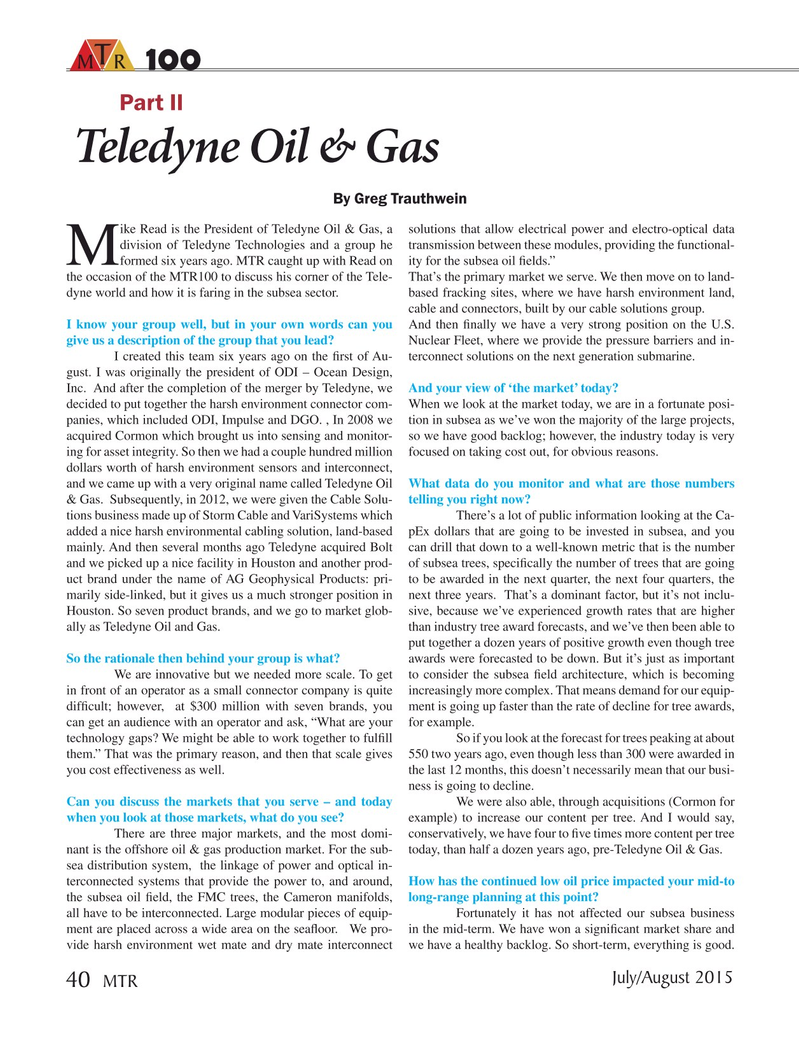
Page 40: of Marine Technology Magazine (July 2015)
Read this page in Pdf, Flash or Html5 edition of July 2015 Marine Technology Magazine
T
M R 100100
Part II
Teledyne Oil & Gas
By Greg Trauthwein ike Read is the President of Teledyne Oil & Gas, a solutions that allow electrical power and electro-optical data division of Teledyne Technologies and a group he transmission between these modules, providing the functional-
Mformed six years ago. MTR caught up with Read on ity for the subsea oil ? elds.” the occasion of the MTR100 to discuss his corner of the Tele- That’s the primary market we serve. We then move on to land- dyne world and how it is faring in the subsea sector. based fracking sites, where we have harsh environment land, cable and connectors, built by our cable solutions group.
I know your group well, but in your own words can you And then ? nally we have a very strong position on the U.S. give us a description of the group that you lead? Nuclear Fleet, where we provide the pressure barriers and in- I created this team six years ago on the ? rst of Au- terconnect solutions on the next generation submarine.
gust. I was originally the president of ODI – Ocean Design,
Inc. And after the completion of the merger by Teledyne, we And your view of ‘the market’ today?
decided to put together the harsh environment connector com- When we look at the market today, we are in a fortunate posi- panies, which included ODI, Impulse and DGO. , In 2008 we tion in subsea as we’ve won the majority of the large projects, acquired Cormon which brought us into sensing and monitor- so we have good backlog; however, the industry today is very ing for asset integrity. So then we had a couple hundred million focused on taking cost out, for obvious reasons.
dollars worth of harsh environment sensors and interconnect, and we came up with a very original name called Teledyne Oil What data do you monitor and what are those numbers & Gas. Subsequently, in 2012, we were given the Cable Solu- telling you right now?
tions business made up of Storm Cable and VariSystems which There’s a lot of public information looking at the Ca- added a nice harsh environmental cabling solution, land-based pEx dollars that are going to be invested in subsea, and you mainly. And then several months ago Teledyne acquired Bolt can drill that down to a well-known metric that is the number and we picked up a nice facility in Houston and another prod- of subsea trees, speci? cally the number of trees that are going uct brand under the name of AG Geophysical Products: pri- to be awarded in the next quarter, the next four quarters, the marily side-linked, but it gives us a much stronger position in next three years. That’s a dominant factor, but it’s not inclu-
Houston. So seven product brands, and we go to market glob- sive, because we’ve experienced growth rates that are higher ally as Teledyne Oil and Gas. than industry tree award forecasts, and we’ve then been able to put together a dozen years of positive growth even though tree
So the rationale then behind your group is what? awards were forecasted to be down. But it’s just as important We are innovative but we needed more scale. To get to consider the subsea ? eld architecture, which is becoming in front of an operator as a small connector company is quite increasingly more complex. That means demand for our equip- dif? cult; however, at $300 million with seven brands, you ment is going up faster than the rate of decline for tree awards, can get an audience with an operator and ask, “What are your for example.
technology gaps? We might be able to work together to ful? ll So if you look at the forecast for trees peaking at about them.” That was the primary reason, and then that scale gives 550 two years ago, even though less than 300 were awarded in you cost effectiveness as well. the last 12 months, this doesn’t necessarily mean that our busi- ness is going to decline.
Can you discuss the markets that you serve – and today We were also able, through acquisitions (Cormon for when you look at those markets, what do you see? example) to increase our content per tree. And I would say, There are three major markets, and the most domi- conservatively, we have four to ? ve times more content per tree nant is the offshore oil & gas production market. For the sub- today, than half a dozen years ago, pre-Teledyne Oil & Gas.
sea distribution system, the linkage of power and optical in- terconnected systems that provide the power to, and around, How has the continued low oil price impacted your mid-to the subsea oil ? eld, the FMC trees, the Cameron manifolds, long-range planning at this point?
all have to be interconnected. Large modular pieces of equip- Fortunately it has not affected our subsea business ment are placed across a wide area on the sea? oor. We pro- in the mid-term. We have won a signi? cant market share and vide harsh environment wet mate and dry mate interconnect we have a healthy backlog. So short-term, everything is good.
July/August 2015 40
MTR
MTR #6 (34-49).indd 40 MTR #6 (34-49).indd 40 8/3/2015 11:37:24 AM8/3/2015 11:37:24 AM

 39
39

 41
41
